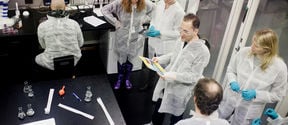Biofilia as a fertile ground for research and experiment
Interview with Marika Hellman and James Evans (Lab Managers, Biofilia)
"Labs and actors."
The increasing artistic interest in the field of art & science has caused higher education institutions to gradually notice the need for biological laboratory facilities that are accessible and open for artistic use. As of today, there exist numerous open and accessible laboratory facilities for artists located in academic institutions, which are comparable to the Biofilia-laboratory at Aalto University[1].
In addition to actual physical labs, many higher education institutions have started offering courses, workshops and full study programs and initiated research projects with an aim to bridge the arts, the sciences and technology on a practical level[2]. Today, possibly even more numerous than the art-focused labs in academic institutions, are the small independent DIY and open-science labs[3] with active member communities. These laboratories enable DIY, artistic and citizen-led science and biology projects beyond the strict limitations of traditional science framing and funding. They offer workshops, project space, mentoring and education for artists, designers, scientists and citizens with an interest in learning about biotechnology, its methods and laboratory work in general. One should also mention that, in addition to these physical labs, there are various small non-academic art organizations that foster art & science and bioart activities with exhibitions, events, talks, workshops and collaborative projects[4].
[1] Symbiotica-lab in the University of Western Australia which establishers Oron Catts and Ionat Zurr were key figures in setting up the Biofilia Laboratory at Aalto University, Incubator Art Lab in University of Windsor Canada, DIY BioLab in Weimar University Germany, public laboratory ART SCIENCE BLR hosted by the Srishti Institute of Art, Design & Technology in Bengaluru India, Coalesce Center for Biological Art in University of Buffalo US and Bio Art Lab in the School of Visual Arts in New York US – these are few examples among various other art & science labs within academic institutions.
[2] For example, the ‘Art and Life Sciences’ by Leiden University that is directed for both art history and biomedical students, and e.g. range of biotech related workshops organized by exMedia lab of the Academy of Media Arts in Cologne Germany. The author (L. Beloff) is partnering two Erasmus+ Strategic partnership projects (Hybrid Lab Network 2019-2022 and ABRA 2020-2023), which both are focused on development across the arts and the sciences.
[3] Examples of such places are Waag Society’s open wetlab in Amsterdam, Bioclub in Tokyo, BioArt Laboratories in Eindhoven, Genspace in New York, Art Laboratory Berlin and Open biolab in Graz – among many more. All these different laboratories have their own focuses and ways of working.
[4] Examples of long-term actors are e.g. Hackteria in Switzerland, Cultivamos Cultura in Portugal, globally functioning Science Gallery network and Bioart Society in Finland, which is a regular collaborator with Aalto’s Biofilia laboratory.
Links:
https://www.symbiotica.uwa.edu.au/
https://www.uni-weimar.de/en/art-and-design/chairs/media-environments/laboratories/diy-biolab/
https://www.buffalo.edu/genomeenvironmentmicrobiome/coalesce.html
https://studiegids.universiteitleiden.nl/index.php/courses/95111/art-and-life-sciences
https://en.khm.de/exmedia_exMedia_Lab/
https://waag.org/en/lab/open-wetlab
https://bioartlab.com/activities#exhibition_desktop
http://www.artlaboratory-berlin.org/
https://realraum.at/wiki/doku.php?id=olga:olga
This is a listing of various open and experimental labs, some of which are already closed and new ones have appeared: https://sphere.diybio.org/browse/?q=&idx=diybiosphere&p=0&dFR%5Bcollection%5D%5B0%5D=labs
https://www.hackteria.org/about/
https://cultivamoscultura.com/what-we-are/
The Science Gallery Network is a global network with galleries and activities affiliated with science universities: https://sciencegallery.org/

Interview with Marika Hellman and James Evans (Lab Managers, Biofilia)

Biofilia is a biological art unit which provides a platform for trans-disciplinary research and education. It provides artists, researchers, students and scholars with the ability to engage with the life sciences and their applications within an artistic and cultural context, thus making creative and critical links between biosciences, engineering and the arts.

Biofilia – Base for Biological Arts, a biological art unit was launched under the School of Arts, Design and Architecture in 2012. It offers a platform for trans-disciplinary research and education that aims to create cultural discussions and innovations around the topics related to the manipulation of life and biological processes at a practical and theoretical level, including philosophical and ethical dimensions.

`Particular Times and Particular Interests` text by Laura Beloff as part of the Outre: Encounters with Non/Living Things Exhibition

Art as We Don’t Know It presents a richly illustrated selection of artworks and bioart research.

Bioart exhibition proposes questions and showcases six experimental art/science projects dealing with living organisms like bacteria and cells.

`Outré: Encounters with Non/living Things` online exhibition